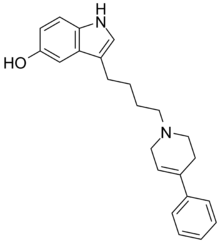Roxindole
 | |
| Clinical data | |
|---|---|
| ATC code |
|
| Identifiers | |
| |
JSmol) | |
| |
Roxindole (EMD-49,980) is a
depression instead.[1][4] It has also been investigated as a therapy for Parkinson's disease and prolactinoma.[5][6]
Roxindole acts as an agonist at the following receptors:[7][8]
- D2 receptor(pKi = 8.55)
- D3 receptor(pKi = 8.93)
- D4 receptor(pKi = 8.23)
- 5-HT1A receptor (pKi = 9.42)
At D2 and possibly D3 receptors roxindole is a partial agonist with preferential actions at autoreceptors and has been touted as a 'selective' autoreceptor agonist, hence the justification of its application as an antipsychotic.[9][10] Weaker activity at the serotonin 1B and 1D receptors has been seen.[11] It is also a serotonin reuptake inhibitor (IC50 = 1.4 nM) and has been reported to act as a 5-HT2A receptor antagonist as well.[8][9][10][12]
